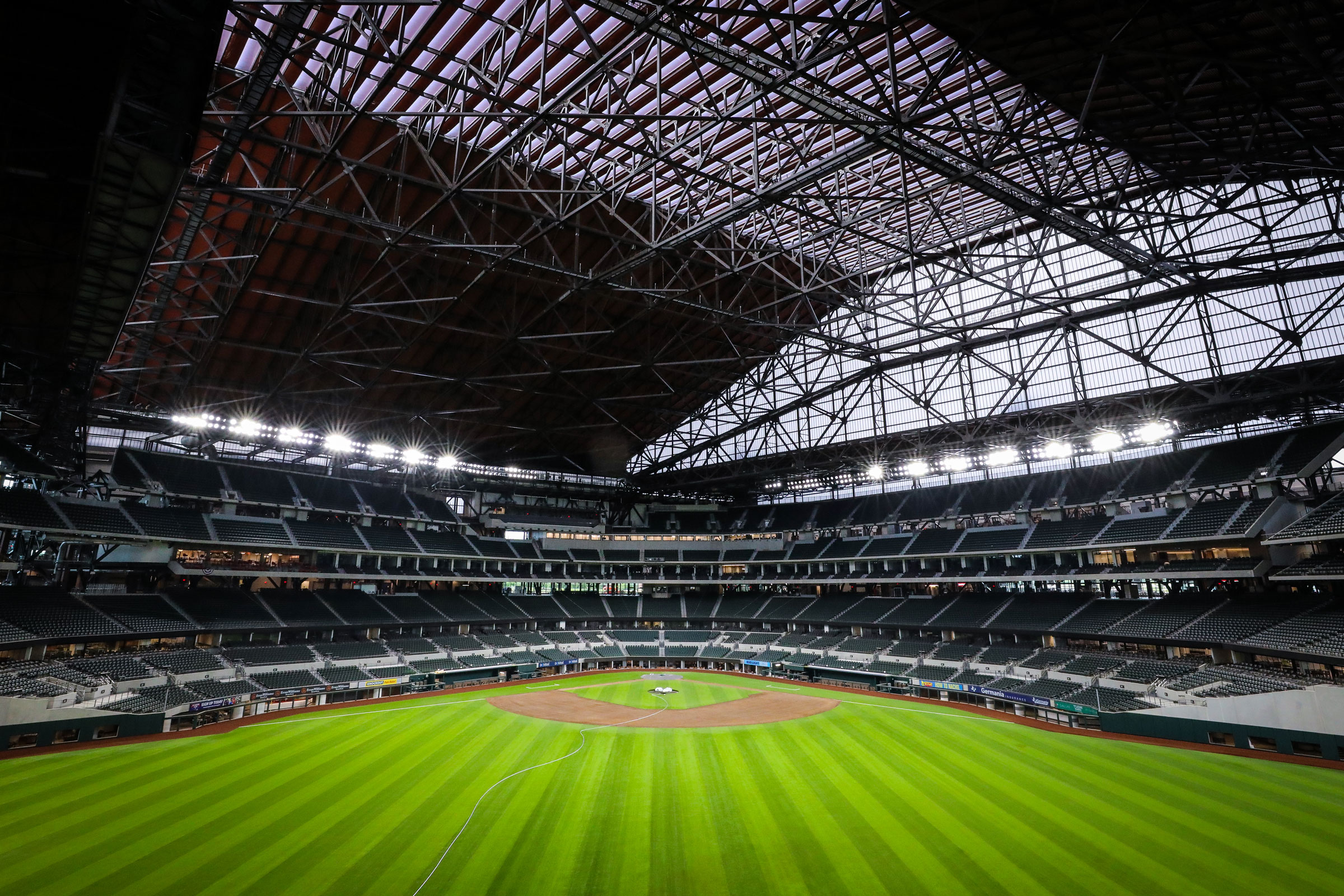Story at a glance:
- Structural steel is getting stronger, with up to 80 KSI steel being produced in Europe.
- New Millennium partners with contractors, architects, and engineers to provide wholly engineered solutions.
- Projects like The Sphere and the Texas Rangers stadium show the ever-evolving possibilities for structural steel.
From music arenas to sports stadiums to convention centers, structural steel is everywhere.
“Many of our projects would simply not be possible without structural steel,” says Gabe Braselton, senior principal architect at Populous. “Its long-span capabilities are essential to our building types, and the innate qualities of structural steel provide designers with the freedom and flexibility to create unique forms and spaces in our buildings.”
But not all structural steel is used to its full potential. Some companies in recent years have pushed the material to new heights—like New Millennium Building Systems’ work on the Sphere, the immersive audio and video arena in Las Vegas that opened in 2023. Complex geometries and intense acoustical testing drove that project from the beginning, guided by an expert team. “We have a lot of in-house expertise. We have designers, structural engineers, and resources to help,” says Alex Therien, market development manager at New Millennium, who worked on the project.
New Millennium works to educate the industry not just about the evolving capabilities of structural steel but also the importance of having teams collaborate early to get ahead of any potential issues. “If you’re in the field trying to resolve issues, the outcomes are going to be less efficient,” Therien says. “That reactionary approach can be extremely detrimental to progress because your options run out.”
The strength of steel is continuing to go higher.
Braselton says the way Populous collaborates with design team members, particularly early in the design process to use structural steel, is changing. “With ever-evolving software and modeling tools, structural steel allows designers to iterate through early design concepts with our structural consultants at our side, sharing scripts and other digital tools to review unique framing solutions with very quick turnaround as our forms and spaces evolve. As we proceed into early design packages, this also allows for the possibility of improved pricing analysis from QS and CM partners,” he says.
Steel itself is also getting stronger, says Justin Barton, principal at Walter P Moore in the Kansas City office. “One of the biggest changes is the grade of structural steel. The strength of steel is continuing to go higher,” he says. “It used to be that 50 KSI was the standard, and now we can regularly get grade 65 steel. A few of the mills in Europe are producing 70 and 80 KSI steel.”
With higher-grade steel, design and construction teams don’t need as much to get the same capacity, Barton says. “That enables us to use less material, which then brings the cost down. You can go from bigger sizes to smaller sizes to save money, and we’re seeing the cost premium to have 70 or 80 KSI steel is not as much as it used to be. Getting more of that information in the marketplace, and mills being able to continually increase the strength, is a really good industry trend.”
While Barton expects KSI will continue to increase for some time, he also anticipates steel will eventually reach its upper limit. “I think what’ll continue to evolve is how we use structural steel from a design standpoint of different complex geometry, which it’s really well suited to,” he says. “I think that’ll continue as design tools continue to progress, particularly from a digital standpoint. Being able to control design geometry and then share that information and that geometry with the steel fabricator so it simplifies the fabrication and erection process—I think that will continue to enable more complex buildings to be built and create some really signature architectural designs.”
Case Study: The Sphere
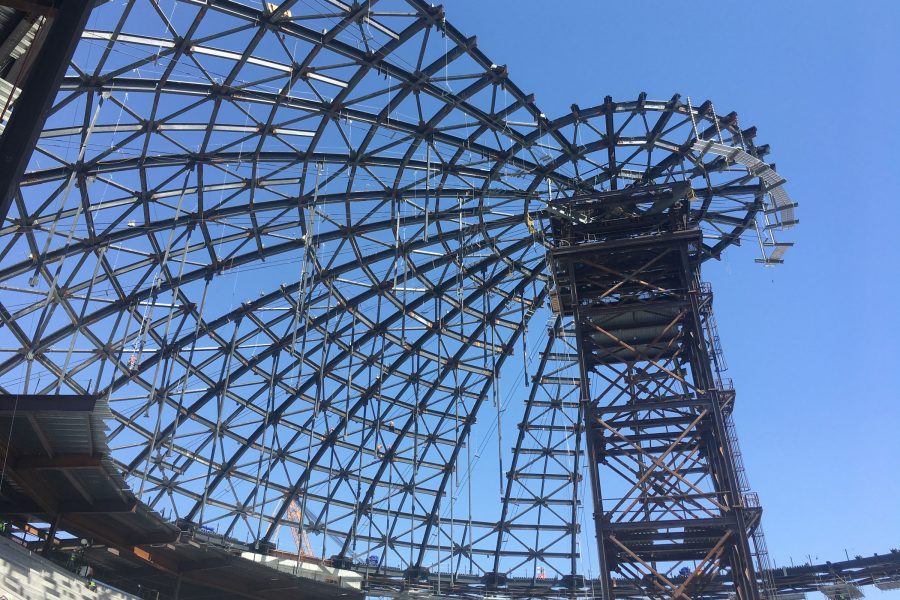
New Millennium’s Deep-Dek allows for sweeping wide-open interior and exterior spaces with dramatic aesthetic appeal and can combine with acoustic treatments to mitigate ambient noise. The Sphere was designed to be a premier audio experience. Photo courtesy of New Millennium
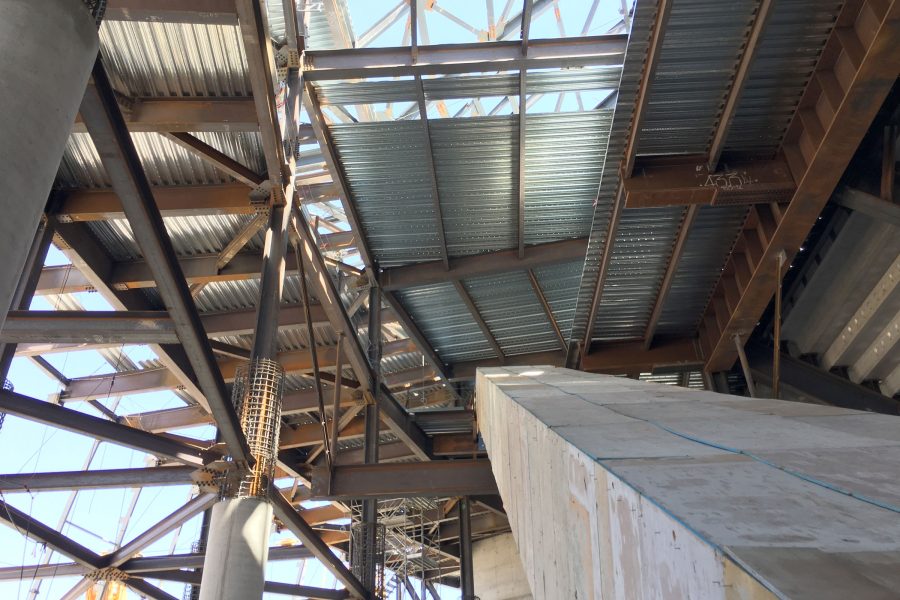
The Sphere uses New Millennium’s 7.5 Deep-Dek to meet a challenging geometry. Photo courtesy of New Millennium
When it comes to complex geometries, there may be no greater complexity than that of the Sphere, designed by Populous with structural steel solutions from New Millennium and 29,100 tons of steel from W&W. The 366-foot-tall, 516-foot-wide venue covers almost 1 million square feet, with a dynamic exosphere displaying 1.2 million LED pucks assembled from more than 400 LED mega panels attached to a steel diagrid that stands as an independent structure from the main building.
The Sphere was designed to be a premier audio experience. “Addressing the acoustics was really important,” Therien says. “Our intent was to investigate and address the ambient noise. We did a series of tests with variations of our deck type called Deep-Dek.”
Deep-Dek allows for sweeping wide-open interior and exterior spaces with dramatic aesthetic appeal and can combine with acoustic treatments to mitigate ambient noise. New Millennium tested multiple iterations of liner panels with varied acoustical batt densities and thicknesses, along with altering perforation size and hole stagger, ultimately refining the design based on their findings. “We did that with the Deep-Dek and N Deck in their cellular acoustical configurations.”
Therien likens an acoustical deck to a Swiss Army knife. Instead of having a standard deck and applying a secondary ceiling system, which costs money and requires an additional team to install, an acoustical deck is all in one. “If you could eliminate that secondary ceiling altogether it eliminates an entire trade, the material waste associated, and the labor involved. That is real sustainability—and think of the time savings.”
Of course, the Las Vegas project began with designing the actual sphere—itself a challenge. “The starting point was devising how to resolve that geometry and trying to minimize skew cutting the deck,” Therien says. In creating the dome, deck panels vary in length, tapering as they reach the pole. “W&W | AFCO is one of the preeminent steel fabricators and erectors. Their ability to think through the execution and see around corners—just outstanding partners to work with.”
The flexibility of steel makes it ideal for any scale, but in large-scale construction it’s a must for open-span, column-free spaces. “You can’t really do it in any other material,” Therien says, adding that for projects like the Sphere or convention centers that tend to have roofs on them, you wouldn’t want a concrete roof because it would be too heavy. “If you use concrete you’re over-designing it in a lot of situations,” he says, noting the exception of projects in hurricane or tornado zones.
Globe Life Field & Prefinishing

Globe Life Field, where the Texas Rangers play baseball, is predominantly structural steel. Photo by Daryl Shields, courtesy of Walter P. Moore
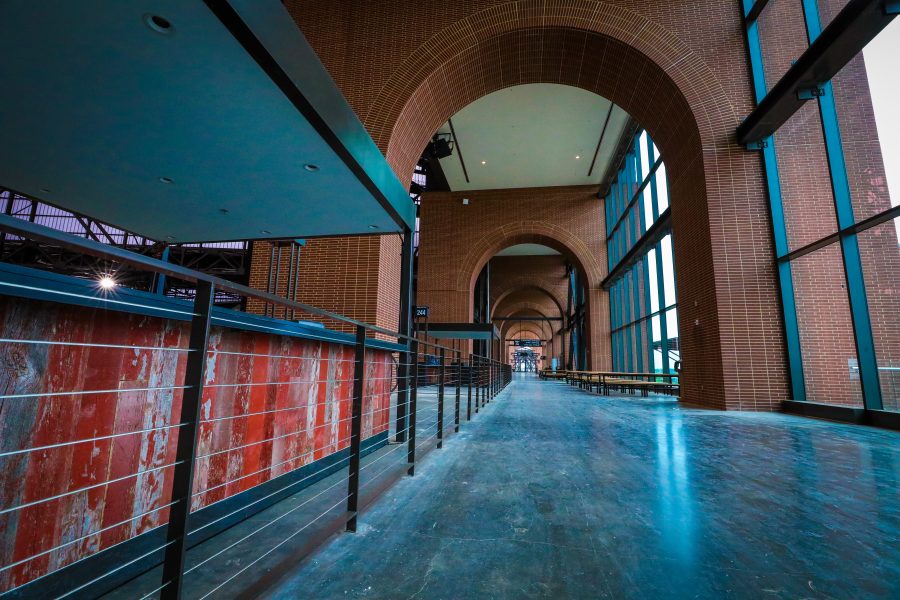
The Rangers baseball stadium used 16,000 tons of structural steel for the ballpark’s bowl and concourse structure and 19,000 tons of structural steel for the ballpark’s roof structure. Photo courtesy of Walter P. Moore
Globe Life Field, where the Texas Rangers play baseball, is also predominantly structural steel. Walter P Moore was the lead structural engineer on the project. Barton, who has been with Walter P Moore for 20 years and focuses on large sports projects, says it’s an impressive project to say the least. The 1.8 million-square-foot project was completed in 2020 with the longest retractable roof panel in the US at 600 feet. The stadium used 16,000 tons of structural steel for the ballpark’s bowl and concourse structure and 19,000 tons of structural steel for the ballpark’s roof structure.
“Structural steel enables the lightweight, long spans of that ballpark and of that roof to be able to span the distance it spans,” Barton says. “One of the unique things about that retractable roof is that it is one giant panel that moves. A lot of other ballparks have two or three panels that tuck underneath each other. This is one giant panel that fully retracts back over a plaza outside the ballpark.”
Therien says using structural steel at a ballpark is ideal because you typically have canopies and various stands. This project also was unique in that it had prefinished decks so crews didn’t have to scramble to paint and color-match after the fact. “We prefinished all of the steel deck on the roof in a color-matched paint. They wanted terra-cotta for the color of the retractable roof,” he says. “The roof deck is a prefinished N Deck by New Millennium in a color-match from the architect. That’s another thing we have brought to these contractors. It’s dangerous to paint that in situ, and also how accurate can it be? Prefinishing was also done on Hard Rock Stadium where the Dolphins play. It’s starting to gain in prevalence.”
Therien says everyone assumes at this point that structural steel will be used for these projects, but they don’t often think about the paint job. “You have to put a finished coating system on exposed steel unless you want it to weather. They want these projects to be a community asset they can show off,” he says. “With a few exceptions stadiums tend to be outdoor environments requiring the use of a three-coat, high-performance coating system because you are subjected to the exterior elements.”
And depending on location, like at Target Field in Minnesota, you need to account for temperature swings and humidity. “Building components need to be able to expand and contract, so these canopy connections are extremely important. You have to make sure you have that finished coating system on it to reduce the corrosion entry points.”
More Structural Steel Benefits
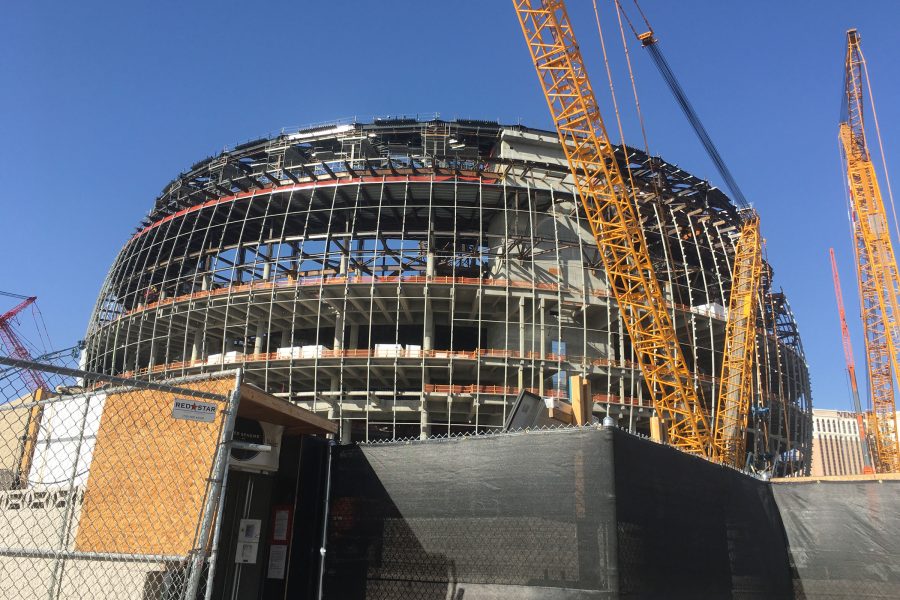
The Sphere uses New Millennium’s 7.5 Deep-Dek to meet a challenging geometry. Photo courtesy of New Millennium
Therien says steel’s greatest asset is its strength-to-weight ratio, spanning capabilities, and ductility. When compared to wood, it has a lot more flexibility and a range of shapes. Wood is also susceptible to mold, dry rot, insect damage, and is flammable, he says.
Concrete has excellent compressive strength, Therien says. “It’s great for flat surfaces, it’s got a good strength-to-depth ratio, but it flows; you have to build formwork for it. It’s excellent for thermal mass and for fire-rated designs, but whether cast-in-place, precast, or block, it has sustainability concerns.”
He says steel is also great because it “plays well” with the other structural building materials. “Steel deck is the perfect complement to concrete in composite design. Mass timber displays the warmth of wood with the reliability of steel in its connections.”
Barton also points to steel as a more sustainable material than, say, concrete, as it can be recycled and already has a lot of recycled material in it. “It is a really good building material. You get a lot of strength from steel. It’s relatively lightweight, and it allows you to create some longer spans,” he says. “All of our arena roofs—all of our Major League Soccer canopies, NFL canopies, those are all structural steel because we can achieve some long spans with something that’s relatively light.” And when something’s light, he says, you can also use a smaller crane, have less foundation loads, and have less to carry.
“Steel is a proven good material and continues to evolve,” Barton says. “It is really one of the core materials and products we use when designing new facilities.”

